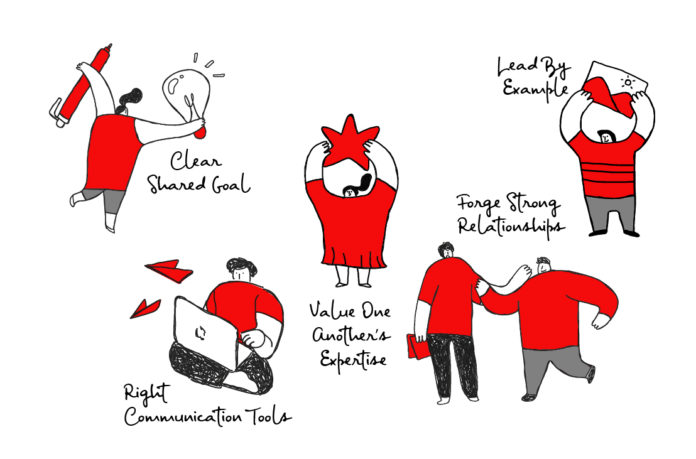It is unsurprising for a group of individuals with different expertise, skill sets, and attitudes to approach work in different ways. However, companies that are and aim to thrive must prioritize a strong collaborative foundation across its teams.
Regardless of the size of the organization, collaborative work within and between teams is increasingly important as some organizations continue to work remotely while others explore the new world of hybrid work.
The healthcare industry is a good example of why multidisciplinary collaboration is a necessity to thrive in this age of disruption.
Brian Burkey, MD, Vice-Chairman of Head and Neck Surgery and Oncology at Cleveland Clinic shared how the Cleveland Clinic employs a multidisciplinary approach to treat their cancer patients. The Clinic establishes a ‘tumor board’ of multidisciplinary practitioners who meet to discuss difficult cancer cases and to work out the best way to treat each patient.
“Another factor that is more or less forgotten is that when there is teamwork in a medical setting, all the parties involved are more flexible with changes, which means their response to a life-threatening situation would be fast and effective, therefore ensuring a successful outcome,” wrote Christian Schuhmacher, CEO of King’s College Hospital London UAE.
As such, other industries should consider adopting a multidisciplinary collaboration approach in their respective workplaces.
Value One Another’s Expertise
It is an almost instinctual thing to divide our colleagues into ‘them and us’ based on one another’s qualifications, training, and approach to work. However, the ‘them and us’ culture is unhealthy for an organization.
“In the past, I have invited E to share how linguistics intertwines with the study of society while R gave a short lecture on astronomy in my World Civilization class. We do this because we recognize each other’s area of speciality(ies) and seek to demonstrate to our students how fields of studies that seemingly have no relation like Math and History are interrelated,” shared Michelle Low.
Low’s example demonstrates that multidisciplinary collaborations create a unique opportunity to learn from each other. In Low’s case, the students witness firsthand the value of multidisciplinary collaboration as their educators collaborate to broaden their individual knowledge and perspectives.
Forge Strong Relationships
An effective multidisciplinary collaboration is only possible if employees are encouraged to engage with one another, in and out of the workplace.
“Anyone should be able to talk to anyone else, at any level, at any time, without fear of reprimand. Company employees are encouraged to engage with anyone else to share feedback or ideas, without having to follow a formal chain of command,” said Pixar Animation Studios co-founder, Ed Catmull.
By adopting open communication methods in an organization, employees can and will learn on-the-job how to appreciate one another and engage in purposeful conversations which can lead to successful multidisciplinary collaborations.
In fact, “research shows workers are up to 20% more satisfied when they have tools that allow them to collaborate,” highlighted Matt Bochenski of Workplace from Facebook.
Right Communication Tools
With the growing trend of flexible work environments, cloud communication tools are increasingly indispensable.
That said, “companies need to provide employees with proper tools and technology for them to do their job,” shared Sami Ammous, Avaya Holdings Corp VP for East Asia and the Pacific.
Therefore, tools like Monday.com allow organizations to “maintain communication on the boards so we have the history and data in one place. The teams no longer have to struggle to schedule meetings between multiple time zones to get on the same page because everything happens inside monday.com. Progress and updates can be accessed anytime, and anywhere, regardless of the time zone,” shared Samyuktha Shivakumar, Operations Lead for Global Marketing of ThoughtWorks.
With this collaboration and communication tool, ThoughtWorks observed a 73% improvement in their global team collaboration.
While the social channels on Slack “are good for a few laughs, but they also help us share common interests, support common causes, and even compound the change we can make,” wrote Julie Liegl, Chief Marketing Officer at Slack.
Clear Shared Goal
As organizations shift between work from home and work in the office, employers must clearly define the shared goals and visions of the organization. By doing so, employees are more likely to utilize their differences in skills, training, and knowledge to accomplish their organization’s goals and visions.
“Unlike the ‘Brown Bag’ sessions wherein educators share their knowledge and ideas about their respective fields of studies or the development of a research which may or may not be mandated by the institution and require some degree of administrative work, the approaches shared … are organic byproducts of our friendship and collective ambition to redefine education,” wrote Low.
“Because people are working jointly, they feel it’s safer to experiment and take risks. And suppose you can get people to collaborate across the organization. In that case, you can help break down the silos that inhibit innovation, share knowledge, and come up with solutions that work across the business – saving you time and money,” added Bochenski.
Lead By Example
Multidisciplinary collaboration is only possible when leaders themselves invest and mirror it.
“If the boss wants to be in partnership with employees, she can’t use her power to make an employee’s experience undiscussable, wrong or uncomfortable to bring up. Otherwise, that partnership goes out the window,” wrote Alex Samur of Slack.
Moreover, “by collaborating, what the manager is saying, essentially, is ‘I don’t have all of the answers; please help me,” added Dr. Jerry VanVactor, an active duty health care administrator in the medical service corps of the U.S. Army.




